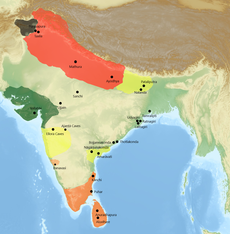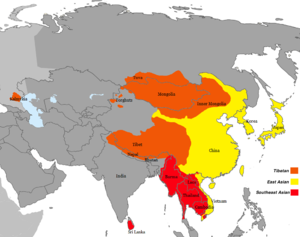Schools of Buddhism
This article lists the main Schools of Buddhism with the major Buddhist traditions.
Early schools


- Sthaviravāda
- Sarvāstivāda
- Kāśyapīya (after 232 BCE)
- Mūlasarvāstivāda (third and fourth centuries)
- Sautrāntika (between 50 BCE and c. 100 CE)
- Vibhajyavāda (prior to 240 BCE; during Aśoka)
- Theravāda (c. 240 BCE)
- Theravāda subschools (see below)
- Mahīśāsaka (after 232 BCE)
- Dharmaguptaka (after 232 BCE)
- Theravāda (c. 240 BCE)
- Pudgalavāda ('Personalist') (c. 280 BCE)
- Vatsīputrīya (under Aśoka) later name: Saṃmitīya
- Sarvāstivāda
- Mahāsāṃghika ('Majority', c. 380 BCE)
- Ekavyahārikas (under Aśoka)
- Golulika (during Aśoka)
- Bahuśrutīya (late third century BCE)
- Prajñaptivāda (late third century BCE)
- Caitika (mid-first century BCE)
Twenty sects
Sthaviravāda split into 11 sects:
- Sarvāstivādin
- Haimavata
- Vatsīputrīya
- Dharmottara
- Bhadrayānīya
- Sammitiya
- Channagirika
- Mahīśāsaka
- Dharmaguptaka
- Kāśyapīya
- Sautrāntika
Mahāsāṃghika split into 9 sects:
Influences on East Asian schools
Monastic/vinaya influence:
- East Asian Buddhist traditions generally follow the monastic tradition of the vinaya of the Dharmaguptaka lineage. However, there are exceptions. For example, some sects within Japan do not follow the traditional vinaya vows; these sects permit non-celibate "monks" or "preists".[1]
Philosophical influence:
- The Japanese Jojitsu is considered by some an offshoot of Sautrāntika; others consider it to be derived from Bahuśrutīya.
- The Chinese/Japanese Kusha school is considered an offshoot of Sarvāstivāda, influenced by Vasubandhu.
Theravada schools
Theravāda refers to the form of Buddhism practiced in Sri Lanka and the Southeast Asia nations of Burma, Thailand, Cambodia, and Laos. While there are a variety of practices and traditions that are subsumed under the name Theravāda, all of these traditions share the same set of core texts and the same monastic lineage.
The forms of Theravada Buddhism tend to reflect the local cultures of the countries in which this form of Buddhism is practiced. Hence, the form of Theravada differs in these countries:
These traditions have influenced many Western Theravada teacher:
Also notable are:
- a small Theravada community in Bangladesh
- Tantric Theravada
Indian Mahayana schools
East Asian schools
- Chinese Buddhism
- Vinaya school[2]
- Jingtu (Pure Land)
- Satyasiddhi (Historical)
- Abhidharmakośa (Historical)
- Dasabhumika school (absorbed into Huayan)
- Tiantai
- Huayan (Avataṃsaka)
- Chan (Zen)
- Tangmi (Esoteric)
- Sanlun (Mādhyamaka)
- Weishi (Yogācāra)
- Korean Buddhism
- Vietnamese Buddhism
- Japanese Buddhism
- Pure Land
- Risshū school (Vinaya school)
- Jojitsu (Satyasiddhi - historical)
- Kusha (Abhidharmakośa - historical)
- Sanron (Mādhyamaka - historical)
- Hossō (Yogācāra)
- Kegon (Avatamsaka)
- Japanese esoteric Buddhism
- Zen
- Nichiren Buddhism
Tibetan Buddhism
- Four main schools
- Other schools/traditions
Also notable is the Ri-mé (non-sectarian) movement.
Other traditions
Tantric traditions
- Tibetan Buddhism
- East Asian Tantric Buddhism (aka Tangmi, Esoteric Buddhism, Chinese Esoteric Buddhsim)
See also
References
- ↑ Why Are Buddhist Monks in Japan Allowed to Get Married?
- ↑ "Archived copy". Archived from the original on 2013-05-28. Retrieved 2013-07-29..
Further reading
- Bhikkhu Sujato (2007). Sects and sectarianism: the origins of Buddhist schools, Taipei, Taiwan: Buddha Educational Foundation; revised edidion: Santipada 2012
- Dutt, N. (1998). Buddhist Sects in India. New Delhi: Motilal Banarsidass.
- Coleman, Graham, ed. (1993). A Handbook of Tibetan Culture. Boston: Shambhala Publications, Inc.. ISBN 1-57062-002-4.
- Warder, A.K. (1970). Indian Buddhism. Delhi: Motilal Banarsidass.
External links
- The Sects of the Buddhists by T. W. Rhys Davids, in the Journal of the Royal Asiatic Society, 1891. pp. 409–422

